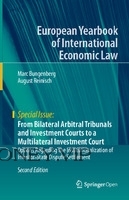
Chapter 1
Executive Summary
1 In March 2018 the Council of the European Union (EU Council or Council) gave the
Commission of the EU (EU Commission or Commission) a mandate to negotiate a
Multilateral Investment Court (MIC). Since July 2017 the United Nations Com-
mission on International Trade Law (UNCITRAL) Working Group III has been
discussing different options for a reform of Investor State Dispute Settlement
(ISDS). The UNCITRAL Working Group III was mandated to:
First, identify and consider concerns regarding ISDS; second, consider whether
reform was desirable in light of any identified concerns; and third, if the Working
Group were to conclude that reform was desirable, develop any relevant solutions to
be recommended to the Commission.
Consensus to develop solutions (thus, enter stage 3) was reached at the Thirty-
seventh session in New York from 1 to 5 April 2019. On 30 April 2019 the Court of
Justice of the European Union decided that the ISDS mechanism provided for by the
free trade agreement between the EU and Canada (Comprehensive Economic and
Trade Agreement—CETA) is compatible with EU Law. The option of a institu-
tionalized as well as multilateralised investor state dispute settlement mechanism
will now be discussed in detail.
2 This study assesses both the option of a two-tiered MIC and of a Multilateral
Investment Appellate Mechanism (MIAM). Both models provide for a permanent,
pre-appointed judiciary according to rule of law standards. As yet, there are no othe
comprehensive and in-depth analyses in academic literature6 regarding the models
being put forward in this study which have been deemed visionary or even revolu-
tionary. Therefore, this study was one of the first feasibility studies considering both
models. Meanwhile, since these first statements and proposals of very general ideas
and announcements in the first edition of this study, the EU Commission has also
come up with in depth analyses that make proposals at least similar to those that can
be found in this study.
3 The starting point of this study is to take a look at the announcements of the EU
Commission and the respective plans in the CETA, the EU-Singapore Investment
Protection Agreement (IPA), the EU-Mexico Global Agreement and the
EU-Vietnam IPA to establish an MIC. The United Nations Conference on Trade
and Development (UNCTAD) made the following observation:
A standing investment court would be an institutional public good serving the interests of
investors, States and stakeholders. The court would address most of the problems outlined
above; it would go a long way to ensure the legitimacy and transparency of the system,
facilitate consistency and accuracy of decisions and ensure independence and impartiality of
investors. However, this solution would also be the most difficult to implement as it would
require a complete overhaul of the current regime through a coordinated action by a large
number of states. [...]
4 A multilateral solution, whatever the form it might take, could result in more
substantive coherence and predictability as well as legal certainty for all concerned
and thus lead to increased acceptance of decisions. Still, the existing network of
mostly Bilateral Investment Treaties (BITs), which contain the substantive standards
of protection, would remain applicable and serve as the material basis for the
institutionalized as well as multilateralized Investor-State dispute settlement system.
5 Should a multilateral consolidation of these substantative standards appear nec-
essary and feasible at some point in the future, it could be attained by a separate
opt-in convention. It would probably be easier to combine such an opt-in convention
on standards of protection with an MIC than with a standalone appellate mechanism.
6 Establishing an MIC or a MIAM entails challenging negotiations and significant
financial costs. Compared to other international courts, it could be run with a budget
within the low double-digit millions. By sharing the premises and staff/secretariat of




